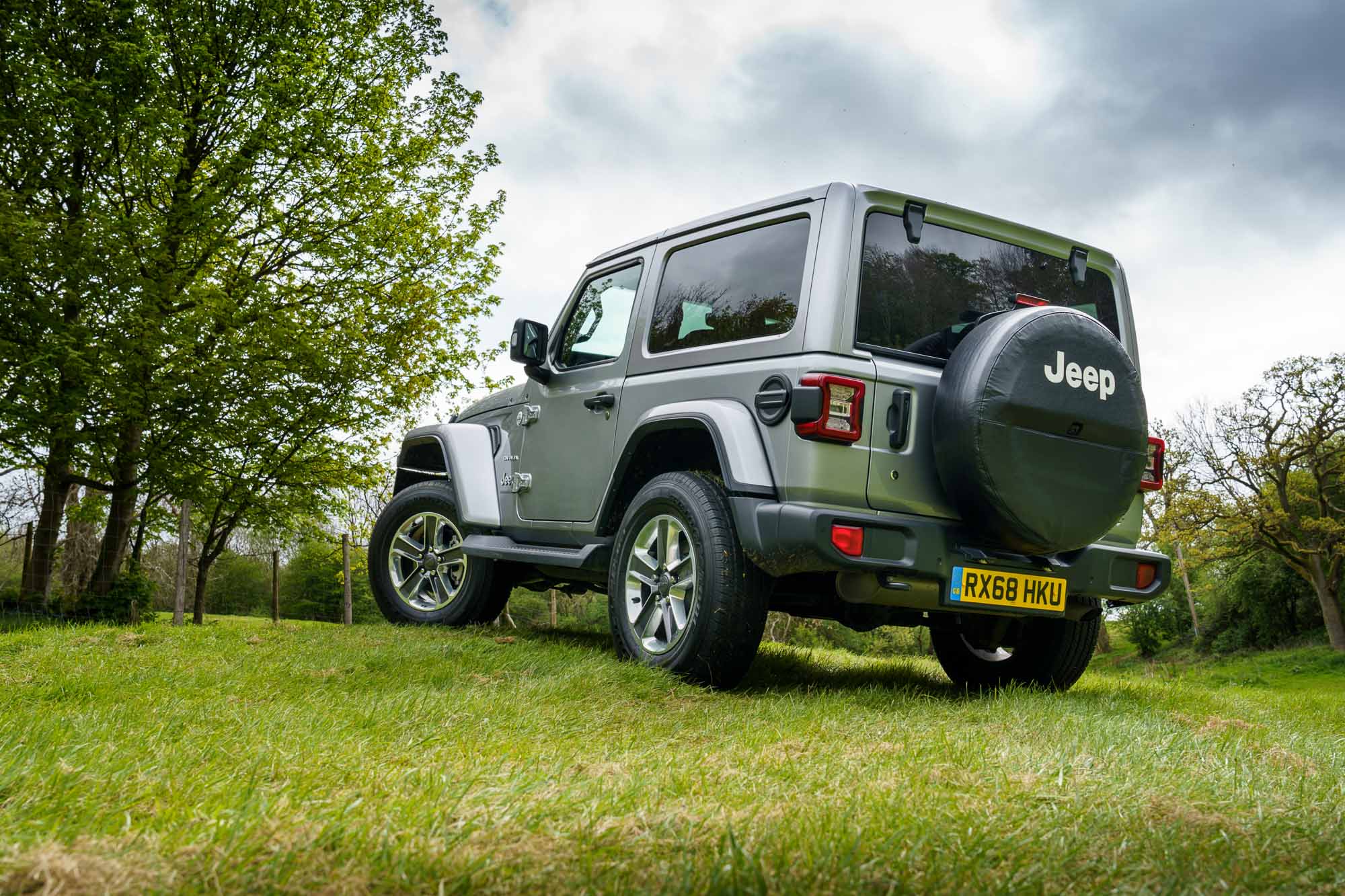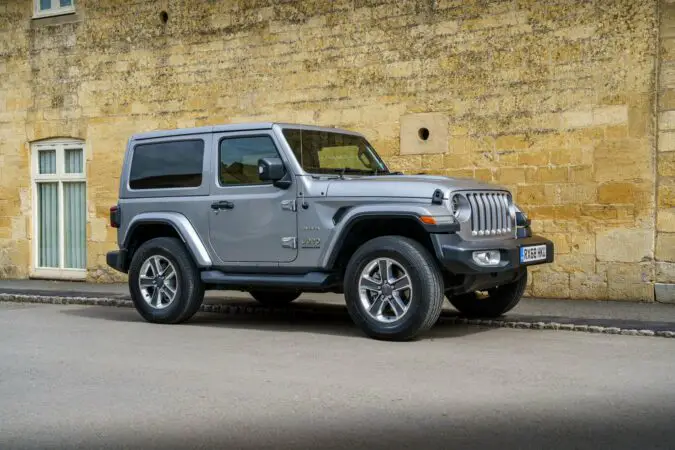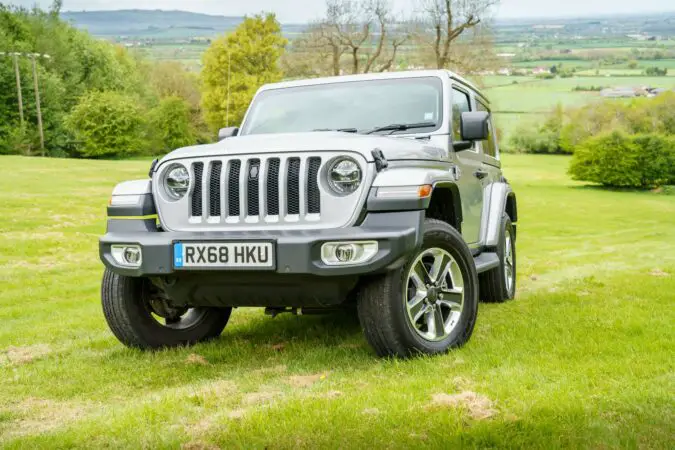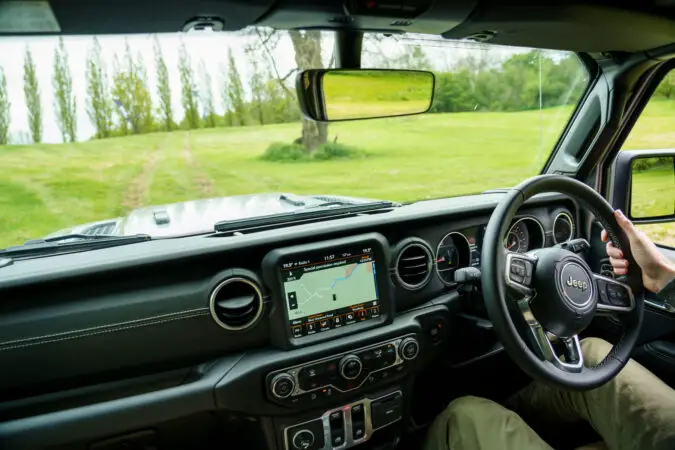Hearing the name Jeep conjures images of an off-road adventure, and the Jeep Wrangler is likely the vehicle most people think of in such a scenario. While the Jeep Wrangler offers a wide range of sophisticated powertrains and creature comforts, it has problems too. In this article, we will delve into the most common Jeep Wrangler problems to guide you with your next purchase.
The first Jeep Wrangler debuted on America’s roadways in 1986. Over the last 20 years, it has been named one of the most beloved and iconic vehicles worldwide, boasting incredible on-road and off-road qualities like non-other. This rugged vehicle can easily tackle anything from off-road adventures to a morning commute. However, purchasing a new or used Jeep Wrangler can be risky.
Jeep Wranglers still have an array of problems that can result in costly and extensive repairs. Each generation has its own set of issues to look out for. In this article, we’re going to look at the most common Jeep Wrangler problems you ought to look out for.
Jeep Wrangler Reliability
Generally, Jeep Wranglers have an above-average reliability score, according to Consumer Reports. In fact, this vehicle was awarded a reliability score of 3.5 out of 5.0 by RepairPal, ranking it the 25th model out of 26 compact SUVs. Maintaining a Wrangler is relatively easy on the wallet, with a typical maintenance cost of $694 and a very nominal repair frequency.
You can reach 280,000 miles fairly easily with most Wranglers before you start to experience any significant problems. With great maintenance and care, Wranglers can last you over 20 years and more than 400,000 miles.
Jeep Wrangler Models By Year
Even though the Wrangler has a low repair frequency, when they experience any problems, the effect tends to be severe. Below are some common Jeep Wrangler problems for different model years.
Common Problems With The 1987-1995 Wranglers
This category is the most reliable of all. However, there are still several issues to keep in mind.
1) Oil Leaks
Even with proper care, vehicles this old are prone to oil leaks. There are various systems in a Wrangler that can leak oil, making the diagnosis a challenge. The respective system contains fluid of different colors that blend with the leaking oil and can be used to identify the root of the leak:
- Transmission fluid is red
- Engine coolant can be green, orange, red, or transparent
- Power steering fluid can be brown, green, or transparent
- New engine oil is amber but turns black or brown over time
Oil leaks are an affordable fix in old Jeep Wranglers. It typically costs between $90 and $110 for diagnosis, while repair varies depending on the source of the leak.
2) Manifold Bolt Failure
The manifold regularly expands and shrinks throughout the duty cycle. After some time, it stretches further than it can retract. This can rupture the mounting stud and make the manifold permanently distorted. This process may also stretch the bolt, forming adequate tension for them to fail.
Although manifold bolts are cheap, if the bolts are not replaced fast or get stuck in the manifold, you may want a new manifold. Replacing an exhaust manifold may cost you around $1,000.
3) Body Damage
The fact that Jeep Wranglers are great off-roaders means that obsolete Jeeps are more susceptible to body damage. Fortunately, you don’t have to fix your Wrangler’s damaged body by yourself. Call your mechanic or contact your local dealer for more information about how they will fix this problem so you can get your vehicle back in perfect shape.
Common Problems With Various Wrangler Generations (1997-2017)
The majority of complaints about the second-generation Wranglers revolved around the ignition switch. This is often because of age; however, you’ll also find faulty ignition switches in third-generation Wranglers. The ignition switch is located behind the lock cylinder and has three essential functions:
- Moving the key to the first position allows you to turn on the radio, roll down the windows, and use other electrical accessories.
- Moving the key to the first position starts the fuel pump and the ignition, pressurizing fuel and making sure the engine is ready to go when it turns over.
- It helps crank the starter when the key is moved to this position.
Here are some signs your Wrangler has a problem with the ignition switch:
- The vehicle fails to start
- Starts then immediately dies
- Stalling while driving
- Battery draining
- Minimal power to accessories
Although ignition switch problems result in extensive issues, it’s relatively cheap to fix. An entire replacement will cost you approximately $130, with the majority covering labor costs. For those familiar with electrical systems, this is a simple DIY fix.
Common Problems With The 1998-2004 Wranglers
Although the second generation has reported few complaints over time, there are still various issues with the 1998 Jeep Wrangler that affect all model years across this range.
1) Leaking Door Seals
Door sealing ought to be a simple element that doesn’t fail quickly. However, this issue has been named one of the most common Jeep Wrangler problems experienced by drivers more often. Leaking in the A-pillar is more common among the 1998 Wranglers, and it remains a cause for concern for the other generations. Door leakage is more prevalent in the 2002 Wranglers.
Poor door seals create a damp atmosphere that can cause foul odors. If the problem persists, the moisture may damage the electrical system. Luckily, door seals are easy to find and connect. For only $50 per door, you can get weather stripping for this task.
2) Transmission Recalls
Jeep Wranglers are eminent for several recalls related to the powertrain and automatic transmissions. The transmission may get stuck or slip in one gear. If your vehicle gets locked in a single gear when driving down the freeway, the effects can be deadly.
While the problem is on watch and Jeep pairs for repairs, transmission problems usually take time to fix.
3) Transfer Case Leaks
Transfer cases are located in 4WD and AWD vehicles and split the transmission between the rear and front wheels. Transfer cases have their own fluid, which generally leaks in Jeep Wranglers. If you experience a leak in your Wrangler, it could be due to a simple seal failure. This could also imply there’s an issue with the overall transfer case, like a faulty bearing.
Even though the average cost of the necessary parts is $30, getting a transfer case oil seal replacement can cost you up to $190.
4) Differential Pinion Seal Leaks
The pinion seal is located inside your vehicle’s differentials. It’s found near the pinion shift and is designed to prevent fluid from leaking out of the differential. However, one of the most significant signs of a faulty pinion seal is if it’s leaking.
If the differential leaks fluid, it can seize your Wrangler’s gears, locking up the rear wheels when driving. To check for a leak, follow the shaft to the rear axle and inspect around the yoke for fresh oil. If you see fresh oil, then you have a pinion seal leak. Another main sign of low fluid in the differential is a whining noise while the vehicle is in motion.
Immediately you notice any of these signs, visit your nearest service center to replace your pinion seal. The average cost for a pinion seal replacement is approximately $250, most of which is the cost of labor. For more insight, check out our guide on how to put oil in your car.
5) Engine Popping
You hop into your vehicle to commence your morning commute, and all of a sudden, you hear a loud sound like a gunshot! And you’re sure it didn’t come from your neighboring yard- so where did the loud pop come from? That’s not a gun, nor is it a firecracker. It’s your vehicle backfiring or popping.
This sound is scary by itself, but it’s even more terrifying if followed by a loss of vehicle power. Your vehicle’s internal combustion engine uses air, fuel, and controlled sparks to power your vehicle. Backfires occur when this system doesn’t work correctly.
Typically, backfires happen when either of the above explosions occurs outside your car’s fuel cylinders. Some backfires spill out via the exhaust system while others travel back up the intake valve, causing an ‘afterfire’- another type of backfire that can sometimes cause visible flames to shoot out of the tailpipe.
Afterfires and backfires ought to be looked after since they can result in decreased fuel efficiency, power loss, and total engine damage. Some of the most common culprits of backfiring or popping in Jeep Wranglers include:
- Misfiring spark plug
- Incorrect engine timing
- Bad spark plug wires
- Poor air-to-fuel ratio
Popping happens under various circumstances, and repair costs vary according to the specific issue your vehicle has.
Common Problems With 2005 Jeep Wrangler
1) Transmission
The 2005 Jeep Wrangler had some severe issues in terms of transmission. According to the National Highway Traffic Safety Administration (NHTSA), most drivers lodged complaints about the SUV’s gear, suggesting that it was prone to popping out while driving. Most owners raised complaints concerning this issue taking place within 30,000 miles, resulting in costly repairs bills of more than $2,000.
2) Fuel Tank
Another commonly cited issue for the 2005 Wrangler was its fuel tank, which tends to overflow when you fill it up all the way. Usually, while filling the tank, the pump ought to shut off on reaching the fill point. However, that wasn’t the case with the 2005 Jeep Wrangler. For many owners, regardless of the gas station they visited, it would regularly flow without warning.
3) Powertrain Control Module (PCM)
Often referred to as your engine’s ‘computer’, the powertrain control module in your Wrangler acts as the brain of the car’s engine. Specifically, the PCM is a combination of other two computers; the transmission control module and the engine control module are housed together in one module.
The Wrangler’s powertrain computer controls numerous processes and functions in your Jeep’s engine. This includes everything from fuel injection parameters to transmission gear shifts to controlling when to activate the check engine light. When your Wrangler’s computer isn’t functioning properly, your vehicle will not run properly either.
Most drivers reported various PCM issues with the 2005 model, including:
- Car not starting – Your Wrangler is difficult to start or doesn’t start completely. Your engine may still crank but won’t start without dynamic inputs from the computer.
- Engine misfiring or stalling – Misfiring or stalling would occur without any pattern concerning severity or frequency.
- Check engine light – The light goes on and off more often and doesn’t appear to link to an exact mechanical problem.
- Engine performance issues – Most of the time, you’d notice a reduction in acceleration, power, and fuel efficiency.
Common Problems With The 2007-2018 Jeep Wranglers
The third-generation Jeep Wranglers are considered the least dependable with low-rated reliability and the most complaints among consumers, with an array of issues affecting each part of the vehicle.
1) Throttle Position Sensor (TPS) Failure
The TPS transmits information to the engine control module (ECM). It shows how open the engine throttle is so the engine control module can appropriately amend emissions, fuel metering, and ignition timing. The TPS is prone to failure because of its complex combination of mechanical and electrical components.
When your Wrangler experiences a TPS failure, its voltage tends to be incorrect, and the check engine light turns on. You can learn more in our guide on the check engine light after oil change. The TPS transmits information to the ECM that affects transmission shift points, resulting in an unexpected shifting problem which is quite dangerous when driving.
Most signs of the TPS failure in the 2007-2018 Jeep Wranglers include:
- Difficulty switching gears
- Reduced fuel and power economy
- Hesitation under acceleration
- Engine stalls abruptly without any reason
- Strange surges in speed
- Delayed shifts
- Jerking or bucking while the engine is under moderate stress
If you happen to notice any of these signs on your Jeep Wrangler, you should replace your TPS. The average cost of replacing a TPS on your Jeep Wrangler ranges between $130 to $150. Labor costs range between $70 and $90, while its parts are approximately $60.
2) The Death Wobble
This is something many Jeep owners experience firsthand. When the wobble kicks in, the steering wheel starts to shake aggressively. This usually occurs after hitting a pothole or sometimes due to pressing hard on the brake pedal.
Though it may feel as if the vehicle’s wheels or axle will fly off, that shouldn’t be a cause for concern- no death cases have ever been reported due to death wobble. If it happens, keep a cool head to help you regain control and proceed to a mechanic safely.
The death wobble happens when the steering elements become damaged or loose. It can also occur when one installs steering parts or suspension incorrectly. The initial step to diagnosis is to examine if any parts are broken or bent in the front suspension.
Probable causes of death wobble consist of:
- Suspension bushings
- Steering knuckles
- Upper control arms
- Lower control arms
- Steering stabilizer
- Ball joints
- Front track bar
- Drag link and tie rod ends
While troubleshooting the death wobble, make sure to tighten all the hardware components to the torque. All these parts ought to be thoroughly inspected for extreme wear and damage. Unbalanced tires and improper wheel alignment aren’t typically the cause of death wobble. However, these conditions can make the issue worse.
Most consumer reports exhibit uncertain solutions to the death wobble, and most owners have tried to fix the issue a couple of times. For the 2007 Jeep Wrangler, most owners reportedly spent approximately $900 on endeavored repairs, and only a few of those repairs fixed the problem permanently.
3) TIPM Failure
The Totally Integrated Power Module (TIPM) functions to preserve the working order of the whole electrical system in your Wrangler. The TIPM facilitates everything from the power window function and fuel pump moving gasoline to the throttle control and headlights. In the absence of the TIPM, even the radio won’t function correctly.
The Grand Cherokee, Liberty, and Wrangler from 2007 to 2015 are all notorious for early TIPM failure. Most consumers reported several issues such as loss of power, and sometimes they were unable to start the vehicle.
Other signs of TIPM failure include:
- Doors unlocking or locking without input
- Power windows get stuck
- Horn hooting at random intervals
- Engine stalling when the vehicle is running
- Airbags deploying at random or refusing to deploy
- The fuel pump remains on and burning out because of persistent use
The air conditioning system, windshield wipers, lights, and radio are all controlled by the TIPM. Owners ought to pay for repairs and replacements to fix the problem, which approximately cost $1,200. Many consumers reportedly started noticing these problems when the vehicle approaches 40,000 miles.
Common Problems With 2019-2020 Jeep Wranglers
The year 2019 and 2020 Jeep Wranglers models were somehow different. However, various issues still arise from time to time in this latest generation of vehicles.
One of the most common complaints about the 2019 and 2020 Wranglers is insufficient power and torque, loose driving wheels, and they’re too expensive for what you get.
There are also reports of a faulty fuel tank that could cause the vehicle to stall. This recall is because of the risk of fire from leaking gas. However, there are no accidents or injuries reported with this problem. This fix is free at the dealership and includes a new fuel tank, as well as a thorough inspection of all other parts that may cause leakage.
Jeep Wrangler Years To Avoid
If you’re looking for a car, the Jeep Wrangler is without a doubt a popular choice among Jeep lovers. However, there are three years you should avoid like the plague; the 2007, 2008, and 2012 Wrangler models had the worst problems for this vehicle.
They are the most challenging of all other years since they experience more problems than usual. These years have been frequently reported with issues ranging from minor embarrassments such as sensors not working or breaking down to major problems like failing transmissions.
Tips For Purchasing A Used Jeep Wrangler
Regardless of possible Jeep Wrangler problems, there are still some reliable Wranglers out there. Here are tips to consider before buying a used Wrangler.
1) Check On Mileage Type
Knowing the overall mileage is essential, but you should also ask about how the car was driven. Wranglers with low mileage could have been operated under severe off-road conditions, making a vehicle with high mileage and gentle use an ideal choice.
2) Decide On Modifications
Most Wranglers have been modified, which can be a better option if you’re after performance. However, a modified vehicle can be more expensive than stock and prone to component failure due to poor installation.
If you go after a modified Wrangler, make sure to find out who completed the installation just in case you need repairs afterward.
3) Verify Mechanical History
If all seems good beneath the hood, you should still ask for complete repairs and maintenance records the car has received. A maintenance history can set you up for early failure.
4) Examine The Body
Inspect the vehicle’s body thoroughly before getting under the hood.
- Outer panels: A significant denting on the outer panels could be a sign of hard use, and thus the vehicle shouldn’t be bought. Rusting could also be a red flag. However, it is easier to acquire replacement panels and fix your Jeep, considering rust hasn’t spread to the frame.
- Undercarriage: The undercarriage is the most valuable indicator of how much life is left in your Wrangler. It doesn’t matter if you have a new engine or a few miles on the transmission if your vehicle’s undercarriage is in poor condition.
- Tires: Inspect tires for irregular wear patterns which are essential for spotting such things as improper rotation and alignment problems. For instance, if you notice the back tires are less worn out than the front tires, it means the front tires have been bearing much engine weight and will have to be replaced.
5) Always Test Drive
Test driving is a chance to unearth and help you keep away from Jeep Wrangler problems. Test drive in the morning to hear how the engine sounds on startup. Pay attention to unexpected loud ticking, stuttering upon idling, and idling during warm-up. When driving, pay attention to the steering wheel, how shifting feels, and look out for any unstable jerks, handling, or vibrations, which would indicate a death wobble in the future.
Jeep Wrangler Problems: In Conclusion…
Each Wrangler had some severe problems as it related to suspension and electrical issues. Newer model years have proven to be much better than the preceding ones. If you’re interested in a Wrangler, check the model year you’re concerned with and if the problems facing it are a concern for you. However, if you experience any of the mentioned Jeep Wrangler problems with your vehicle, make sure to contact your mechanic promptly or visit your nearest service center for repair.
Regardless of what year Wrangler you have, each wrangler is special to the Jeep family, and adventure is still 100% possible. Still, remember to always be wary of those Jeep Wrangler problems.
Frequently Asked Questions
If you’re still curious to learn more about all the Jeep Wrangler problems, our FAQs here might help…
Are Jeeps Reliable
Despite its iconic and timeless allure, there have been divisive opinions over the reliability of Jeeps. In particular, the Jeep Wrangler. Statistics show that Jeeps (and that includes the Wrangler) are generally more unreliable than what you might expect. While faults and problems might not be as prevalent as in some other (more unreliable cars), a Jeep might cost you more to fix those issues. It’s made worse knowing that some long-term issues can appear early on during your ownership period, even with low mileage. Then, there’s the fact that the recent Jeep Wranglers have already suffered numerous recalls, further muddying its reputation for building dependable and reliable cars.
Are Jeep Wranglers Safe
The Jeep Wrangler has understandably garnered some skepticism concerning its safety records. Being such a boxy car with removable body panels, one would typically expect that the Wrangler isn’t as robust as some other off-roaders and SUVs in the event of an accident. Indeed, its latest 2022 crash safety tests (by the IIHS) showed that it’s not the safest vehicle of its class, by far. Its small overlap crash test rating was only acceptable. Meanwhile, the NTHSA scored the latest Wrangler a 4 out of 5 for frontal impacts. This goes for the overall front, front driver side, and front passenger side tests. On top of that, its rollover score was just 3 out of 5.
How Long Do Jeep Wranglers Last
While they may present some reliability concerns throughout your ownership period, Jeeps are at least very robust and long-lasting. Even the most unreliable Jeeps could easily last beyond 100,000 miles. On average, a Wrangler should handily go beyond 200,000 to 250,000 miles. Or, even go upward of 400,000 miles, if you really take good care of them. Given that the average American drives around 15,000 miles a year, you could expect at least 10 to 15 years’ worth of durable and dependable ownership. Once that milestone has been crossed, you’ll likely have to perform a minor restoration and rebuild of your Wrangler, including rebuilding complex parts such as the engine and gearbox.
Where Is The Jeep Wrangler Made
For such an iconic symbol of America and the American auto industry, it’s only right that the Jeep Wrangler is made in the USA. Specifically, Jeep’s Wranglers are built in the Toledo Assembly Complex, based in Toledo, Ohio. In fact, every Wrangler sold around the world since 1992 was put together there. Currently, the Wrangler’s production, even more specifically, is based in the Toledo Complex’s North Plant – a section of the massive facility dedicated to the Wrangler. As of now, the Toledo Assembly Complex has very nearly 6,500 employees, working across a floor space spanning 3.64-million square feet. Prior to this, the Wrangler was built in Brampton, Ontario, Canada.
What Does JK Stand For Jeep
The JK-series Jeep Wrangler had a pretty long production cycle, relative to most other cars. It succeeded the TJ-generation Wrangler and began production in 2007. It stayed in production for 11 more years, before the JK Wrangler was finally replaced by the JL Wrangler (the fourth generation) in 2018. Some folks did wonder though, as to the meaning of ‘JK’. In its early years, the first road-going Jeep was referred to as the ‘CJ’, or Civilian Jeep. So, wondered if ‘JK’ stood for anything. In actuality, there’s no meaning to those two letters beyond helping to distinguish between different generations of the Wrangler. That included the YJ, TJ, KJ, and most recently, the JL.




